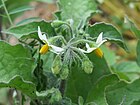Note: This is a project under development. The articles on this wiki are just being initiated and broadly incomplete. You can Help creating new pages.
Difference between revisions of "Solanum nigrum - Kakamachi"
(→Photo Gallery) |
|||
| Line 61: | Line 61: | ||
<gallery class="left" caption="" widths="140px" heights="140px"> | <gallery class="left" caption="" widths="140px" heights="140px"> | ||
S.nigrum-3.JPG | S.nigrum-3.JPG | ||
| − | + | File:Solanum Nigrum Berries.jpg | |
20150606Solanum nigrum1.jpg | 20150606Solanum nigrum1.jpg | ||
Revision as of 17:32, 8 January 2019
Kakamachi is native to Eurasia and introduced in the Americas, Australasia, and South Africa. Parts of this plant can be toxic to livestock and humans. Nonetheless, ripe berries and cooked leaves of edible strains are used as food in some locales, and plant parts are used as a traditional medicine.
Contents
- 1 Uses
- 2 Parts Used
- 3 Chemical Composition
- 4 Common names
- 5 Properties
- 6 Habit
- 7 Identification
- 8 List of Ayurvedic medicine in which the herb is used
- 9 Where to get the saplings
- 10 Mode of Propagation
- 11 How to plant/cultivate
- 12 Commonly seen growing in areas
- 13 Photo Gallery
- 14 References
- 15 External Links
Uses
Ulcer, Indigestion, Fever, Skin Diseases, Kidney problems, Jaundice, Pimples, Diarrhea, Sore throats
Parts Used
Chemical Composition
Phytochemical screening yielded alkaloids, saponins, tannins, flavonoids, and proteins[1]
Common names
| Language | Common name |
|---|---|
| Kannada | |
| Hindi | Mokoi |
| Malayalam | Mulaku-thakkali |
| Tamil | Manatakkali |
| Telugu | Kasaka |
| Marathi | NA |
| Gujarathi | NA |
| Punjabi | NA |
| Kashmiri | NA |
| Sanskrit | |
| English | Black nightshade, Black-berry night shade |
Properties
Reference: Dravya - Substance, Rasa - Taste, Guna - Qualities, Veerya - Potency, Vipaka - Post-digesion effect, Karma - Pharmacological activity, Prabhava - Therepeutics.
Dravya
Rasa
Tikta (Bitter)
Guna
Laghu (Light), Snigda (slimy)
Veerya
Ushna (Hot)
Vipaka
Katu (Pungent)
Karma
Kapha, Vata
Prabhava
Habit
Identification
Leaf
| Kind | Shape | Feature |
|---|---|---|
| Simple | Alternate | The leaves are Blade ovate, elliptic or diamond-shaped, thin, margin large-toothed or sometimes entire |
Flower
| Type | Size | Color and composition | Stamen | More information |
|---|---|---|---|---|
| Unisexual | 6–14 mm | Yellow | 5 | Flowers Season is July–October |
Fruit
| Type | Size | Mass | Appearance | Seeds | More information |
|---|---|---|---|---|---|
| Spherical | 5–10 mm | black or sometimes green when ripe | slightly wider than long | - | {{{6}}} |
Other features
List of Ayurvedic medicine in which the herb is used
- Vishatinduka Taila as root juice extract
Where to get the saplings
Mode of Propagation
How to plant/cultivate
Black nightshade is cultivated as a food crop on several continents, including Africa and North America. The leaves of cultivated strains are eaten after cooking[3]
Commonly seen growing in areas
cultivated land, heaps of earth, wasteland.
Photo Gallery
References
External Links
- Ayurvedic Herbs known to be helpful to treat Ulcer
- Ayurvedic Herbs known to be helpful to treat Indigestion
- Ayurvedic Herbs known to be helpful to treat Fever
- Ayurvedic Herbs known to be helpful to treat Skin Diseases
- Ayurvedic Herbs known to be helpful to treat Kidney problems
- Ayurvedic Herbs known to be helpful to treat Jaundice
- Ayurvedic Herbs known to be helpful to treat Pimples
- Ayurvedic Herbs known to be helpful to treat Diarrhea
- Ayurvedic Herbs known to be helpful to treat Sore throats
- Herbs with Fruits used in medicine
- Herbs with Leaves used in medicine
- Herbs with common name in Hindi
- Herbs with common name in Malayalam
- Herbs with common name in Tamil
- Herbs with common name in Telugu
- Herbs with common name in English
- Habit - Plant
- Index of Plants which can be propagated by Seeds
- Herbs that are commonly seen in the region of cultivated land
- Herbs that are commonly seen in the region of heaps of earth
- Herbs that are commonly seen in the region of wasteland
- Herbs






